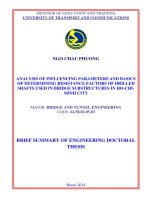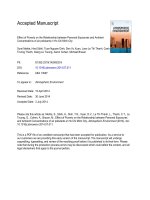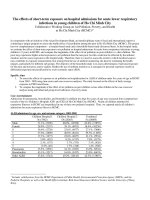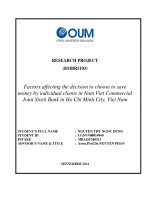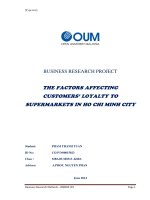Determining the contributing factors to traffic accident in Ho Chi Minh city using binary logit model
Bạn đang xem bản rút gọn của tài liệu. Xem và tải ngay bản đầy đủ của tài liệu tại đây (755.11 KB, 5 trang )
TẠP CHÍ KHOA HỌC CÔNG NGHỆ GIAO THÔNG VẬN TẢI, SỐ 21-11/2016
21
DETERMINING THE CONTRIBUTING FACTORS TO TRAFFIC
ACCIDENT IN HO CHI MINH CITY USING BINARY LOGIT
MODEL
ỨNG DỤNG MÔ HÌNH HỒI QUY LOGIT NHỊ THỨC ĐỂ XÁC ĐỊNH CÁC YẾU
TỐ ẢNH HƯỞNG ĐẾN TAI NẠN GIAO THÔNG Ở THÀNH PHỐ HỒ CHÍ MINH
Tran Quang Vuong
University of Transport and Communications Campus in Ho Chi Minh City
Abstract: Traffic accident patterns, the severity level and the factors determination to the
accidents have been investigated in this research. The results might be helpful for effective measures
suggestion to improve traffic safety at signalized intersections. A case study is conducted in Ho Chi
Minh City (HCMC), Vietnam. Historical traffic accident data in the city are collected during five
years (2011-2015). Binary logit models have been used to identify contributing factors to serious
traffic accident. The results show that the involvement of intersection type, land use and road type are
contributing factors to the accident severity. Based on the findings, strategies and measures for safety
improvement are formulated and discussed.
Keywords: Road traffic accident, signalized intersection, logit model, traffic safety measures,
factor analysis
Tóm tắt: Nghiên cứu này tập trung phân tích đặc điểm tai nạn, mức độ nghiêm trọng và các yếu
tố ảnh hưởng đến tai nạn. Kết quả nghiên cứu sẽ là căn cứ rất hữu ích để đề xuất các giải pháp hiệu
quả nhằm nâng cao an toàn giao thông tại các nút giao thông có đèn tín hiệu. Nghiên cứu này được
thực hiện cho trường hợp ở Thành phố Hồ Chí Minh, Việt Nam, dựa trên dữ liệu thống kê về tai nạn
giao thông trong 5 năm (2011-2015). Mô hình hồi quy logit nhị thức được sử dụng để xác định các
yếu tố ảnh hưởng đến tai nạn giao thông nghiêm trọng. Kết quả phân tích cho thấy loại nút giao
thông, vị trí nút giao và loại đường là những yếu tố ảnh hưởng đến mức độ nghiêm trọng của tai nạn.
Dựa vào kết quả nghiên cứu này để xuất các chính sách, giải pháp nhằm nâng cao an toàn giao thông.
Từ khóa: Tai nạn giao thông đường bộ, nút giao thông có đèn tín hiệu, mô hình logit, giải pháp
an toàn giao thông, phân tích yếu tố.
1. Introduction
Nearly 25 percent of all fatal crashes
occur at intersections and about 30 percent of
those are at intersections controlled by
signals. In 2015, the number of traffic
accident, fatalities, injuries which occurrence
in HCMC, have been slightly decreased
accounted for 3,694 (accidents); 693
(fatalities) and 3,301 (injuries). Although,
this showed that comparison with 2014, the
number of traffic accident, fatalities and
injuries in 2015 have slightly reduced,
accounted for 14.51%, 4.15% and 18.07%,
respectively, these increase at signalized
intersections in HCMC accounted for 41% of
total accident occurrence at intersections
(9.7% of total traffic accident in HCMC).
Until now, there is lack of empirical research
about
traffic
safety
for
signalized
intersections under mixed traffic conditions
since most of previous research on this topic
focusing on vehicle dominance. To address
the road traffic accident problems, it is
necessary to deeply understand contributing
factors to traffic accident. The objectives of
this research are to investigate traffic accident
patterns, the severity levels and contributing
factors to traffic accidents. This study aims,
however, at exploring not all contributing
factors, since substantial limitations in data
obtained from accident reports. Logistic
regression was used in this study to estimate
the effect of the significant contributing
factors to accident severity.
This paper are divided into five parts,
introduct��������������������������������������������������������������������������������������������������������������������������������������������������������������������������������������������������������������������������������������������������������������������������������������������������������������������������������������������������������������������������������������������������������������������������������������������������������������������������������������������������������������������������������������������������������������������������������������������������������������������������������������������������������������������������������������������������������������������������������������������������������������������������������������������������������������������������������������������������������������������������������������������������������������������������������������������������������������������������������������������������������������������������������������������������������������������������������������������������������������������������������������������������������������������������������������������������������������������������������������������������������������������������������������������������������������������������������������������������������������������������������������������������������������������������������������������������������������������������������������������������������������������������������������������������������������������������������������������������������������������������������������������������������������������������������������������������������������������������������������������������������������������������������������������������������������������������������������������������������������������������������������������������������������������������������������������������������������������������������������������������������������������������������������������������������������������������������������������������������������������������������������������������������������������������������������������������������������������������������������������������������������������������������������������������������������������������������������������������������������������������������������������������������������������������������������������������������������������������������������������������������������������������������������������������������������������������������������������������������������������������������������������������������������������������������������������������������������������������������������������������������������������������������������������������������������������������������������������������������������������������������������������������������������������������������������������������������������������������������������������������������������������������������������������������������������������������������������������������������������������������������������������������������������������������������������������������������������������������������������������������������������������������������������������������������������������������������������������������������������������������������������������������������������������������������������������������������������������������������������������������������������������������������������������������������������������������������������������������������������������������������������������������������������������������������������������������������������������������������������������������������������������������������������������������������������������������������������������������������������������������������������������������������������������������������������������������������������������������������������������������������������������������������������������������������������������������������������������������������������������������������������������������������������������������������������������������������������������������������������������������������������������������������������������������������������������������������������������������������������������������������������������������������������������������������������������������������������������������������������������������������������������������������������������������������������������������������������������������������������������������������������������������������������������������������������������������������������������������������������������������������������������������������������������������������������������������������������������������������������������������������������������������������������������������������������������������������������������������������������������������������������������������������������������������������������������������������������������������������������������������������������������������������������������������������������������������������������������������������������������������������������������������������������������������������������������������������������������������������������������������������������������������������������������������������������������������������������������������������������������������������������������������������������������������������������������������������������������������������������������������������������������������������������������������������������������������������������������������������������������������������������������������������������������������������������������������������������������������������������������������������������������������������������������������������������������������������������������������������������������������������������������������������������������������������������������������������������������������������������������������������������������������������������������������������������������������������������������������������������������������������������������������������������������������������������������������������������������������������������������������������������������������������������������������������������������������������������������������������������������������������������������������������������������������������������������������������������������������������������������������������������������������������������������������������������������������������������������������������������������������������������������������������������������������������������������������������������������������������������������������������������������������������������������������������������������������������������������������������������������������������������������������������������������������������������������������������������������������������������������������������������������������������������������������������������������������������������������������������������������������������������������������������������������������������������������������������������������������������������������������������������������������������������������������������������������������������������������������������������������������������������������������������������������������������������������������������������������������������������������������������������������������������������������������������������������������������������������������������������������������������������������������������������������������������������������������������������������������������������������������������������������������������������������������������������������������������������������������������������������������������������������������������������������������������������������������������������������������������������������������������������������������������������������������������������������������������������������������������������������������������������������������������������������������������������������������������������������������������������������������������������������������������������������������������������������������������������������������������������������������������������������������������of
accide nt
1.000
-.042 1.000
.412
.670** .061 1.000
.000
.239
.188** -.013 .179** 1.000
.000 .803 .001
.679** -.029 .391** .181**
.000
.577
.000
1.000
.000
.282** .166** .252** .203**
.000 .001 .000 .000
.159** 1.000
.002
4.3 Development of logistic model
The entry method of logistic regression
was followed using SPSS version 21. The
Omnibus tests of traffic accident severity
24
Journal of Transportation Science and Technology, Vol 21, Nov 2016
model coefficients is analyzed to assess (percentage correct 95%) while only 18.2% is
whether data fit the model or not as percentage correct for fatal accident
illustration in Table 2.
prediction. From Wald - value test at Table 4,
it appears that the variables loc, Uroad,
Table 2. Omnibus Tests of Model Coefficients.
Proad, Croad and Zone 2, show some
Chi-square
df
Sig.
Step 1 Step
47.081
5
.000
significant effect (loc, Uroad, Proad, Croad
Block
47.081
5
.000
are about significant).
Model
47.081
5
.000
The specified model is significant (Sig <
0.05), hence it is recommended that the
independent variables improve on the
predictive power of the null model.
Table 3 contains the two pseudo R2
measures that are Cox - Snell and
Nagelkerke. Cox and Snell’s R-square
attempts to imitate multiple R - square based
on ‘likelihood’, but its maximum can be (and
usually is) less than 1.0, making it difficult to
interpret. Here it is indicating that 11.8% of
the variation is explained by the logistic
model.
The Nagelkerke modification that does
range from 0 to 1 is a more reliable measure
of the relationship. Nagelkerke’s R2 will
normally be higher than the Cox and Snell
measure. In this case it is 0.263 indicating the
relationship of 26.3% between the predictors
and the prediction. In addition, in Table 3
Hosmer - Lemeshow (H - L) test illustrate the
significance of the developed logistic
regression models (sig. >0.05).
Table 3. Goodness of fit (Pseudo R2 and H-L Test).
Pse udo R2 Te st
-2 Log
likelihood
Cox & Snell R Nagelkerke R
Square
Square
1
.118
.263
176.333a
a. Estimation terminated at iteration number 7 because
parameter estimates changed by less than .001.
Ste p
Ste p
1
Hosme r and Le me show Te st
Chi-square
df
5.739
4
Sig.
.220
Our H - L statistic has a significance of 0.22
which means that it is not statistically
significant and therefore our model is quite
good fit. Rather than using a goodness – of fit statistic, we often want to look at the
proportion of cases we have managed to
classify correctly. In a perfect model, the
overall percent correct will be 100% for all
cases. In our study overall 88.3% were
correctly classified. Nevertheless, it trends
skew prediction for non - fatal accident
Table 4. The result of Wald test.
B
S.E. Wald
df
Sig. Exp(B)
loc
.770
.426 3.258
1
.049
2.159
Uroad
1.008
.522 3.727
1
.049
2.740
Proad
.929
.415 5.020
1
.025
2.533
Croad
1.188
.563 4.451
1
.035
3.280
Zone 2
.792
.541 2.143
1
.043
2.207
Consta -4.422
.558 62.782
1
.000
.012
nt
a. Variable(s)
entered on step 1: loc, Uroad, Proad, Croad, Zone2.
Step
1a
According to the previous analysis, the
logit model with the significant variables is
as follows:
g(x) = - 4.422 + 0.77loc + 1.008Uroad +
0.929Proad + 1.188Croad + 0.792zone (9)
Hence the logistic regression model
developed in this study is
(x) = eg(x)/ (1+eg(x)), where g(x) in Eqs.(9)
4.4 Model interpretation
Interpretation of any models means the
ability to explain practical inferences from
the estimated coefficients. The estimated
coefficients for the independent variables
represent the trend or rate of change of the
dependent variables per unit of change in the
independent variable. The interpretation of
the model developed in this study are
presented in detailed, as follows
4.4.1. Impact of location on accident
severity
It should pay attention that due to ‘loc’
has two levels:
loc = 1 (fatal accident occurrence at
junction and the others).
loc = 0 (fatal accident occurrence at
intersections).
According to this coding, our model
shows loc in the logit model with the
coefficient of 0.77. To interpret this
parameter, the logit difference should be
computed as follows:
Logit (fatal accident/ junction & other)
=
Logit (fatal accident/ Intersection)
TẠP CHÍ KHOA HỌC CÔNG NGHỆ GIAO THÔNG VẬN TẢI, SỐ 21-11/2016
=
Logit difference
=
Hence the odds ratio is e1 =e0.77 = 2.16
This value shows that the odds of being
in a fatal accident at a junction and the others
location are 2.16 higher than those at an
intersection. By using the same method, we
can explain the zone 2 factor to impact on
accident severity easily, the odds of being in
a fatal accident happening in zone 2 are 2.2
(e0.792) higher than those occurrence related to
zone 1 and zone 3.
4.4.2. Impact of Uroad on accident
severity
2(1.008) measures the differential effect
on the logit of two cases, whether fatal
accident occurrence on urban road or not
To interpret this parameter, the logit
difference is computed first:
Logit (Fatal/Uroad)
For any other type of road:
Logit (Fatal/not Uroad)
=
Logit difference
=
Hence the odds ratio is e(-1.109) = 0.33
Thus, the odds that accident will be fatal,
in case it occurrences on urban road is 0.33
times its being fatal related to the other type
of road.
The similar method was used to compute
the odds for Proad and Croad, which account
for 0.28 and 0.47, respectively.
5. Conclusions
Logit model was developed in this study
in order to determine significant contributing
factors to accident severity in HCMC basing
on response variable which is binary nature
(i.e. has two categories – fatal or non-fatal)
with three variables namely, type of road,
location and land use. This model is
reasonable statistic fit with 88.3% overall
25
percentage, although it trend skew prediction
for non - fatal accident case (18.2%).
The findings might help the authorities in
HCMC should focus on improvement safety
at junctions in zone 2 where involve
commune road for their strategies. It also
help the authorities that should be pay
attention to make own safety policies for each
zone instead of for whole HCMC as they
have made before. This may make safety
policies more cost - effectively.
The odds presented in this paper can be
used to help establish priorities solutions to
reduce serious accident. Such as the odds of
being involved in a fatal accident at junctions
and other on commune road in zone 2, where
there is few policeman to control the traffic,
lack of traffic signs and drivers with low
safety awareness, are relatively higher than
those for other cases.
It is important should pay attention that,
some significant variables such as road
surface, traffic signal pattern, light condition,
collision type, license status and so on which
are not available or difficult to obtain in
HCMC condition. So they are not including
in this research. Nevertheless, the findings of
this study can be considered as guidance
methods for future study when these
variables are available
References
[1] Yau, K.K.W (2004), Risk factors affecting the severity of
single vehicle traffic accidents in Hong Kong.
Accident Analysis & Prevention.
[2] Abdel-Aty et al., (2005), Exploring the overall and
specific crash severity levels at signalized
intersections. Accident Analysis & Prevention.
[3] Yan, X. et al., (2005), Characteristics of rear-end
accidents at signalized intersections using multiple
logistic regression model. Accident Analysis &
Prevention.
[4] Huang, H. et al., (2008), Severity of driver injury and
vehicle damage in traffic crashes at intersections: A
Bayesian hierarchical analysis. Accident Analysis &
Prevention.
[5] Jin, Y., X. Wang, and X. Chen (2010). Right-angle
crash injury severity analysis using ordered probability
models. Intelligent Computation Technology and
Automation (ICICTA), IEEE.
Ngày nhận bài: 26/9/2016
Ngày chuyển phản biện: 30/9/2016
Ngày hoàn thành sửa bài: 21/10/2016
Ngày chấp nhận đăng: 28/10/2016

